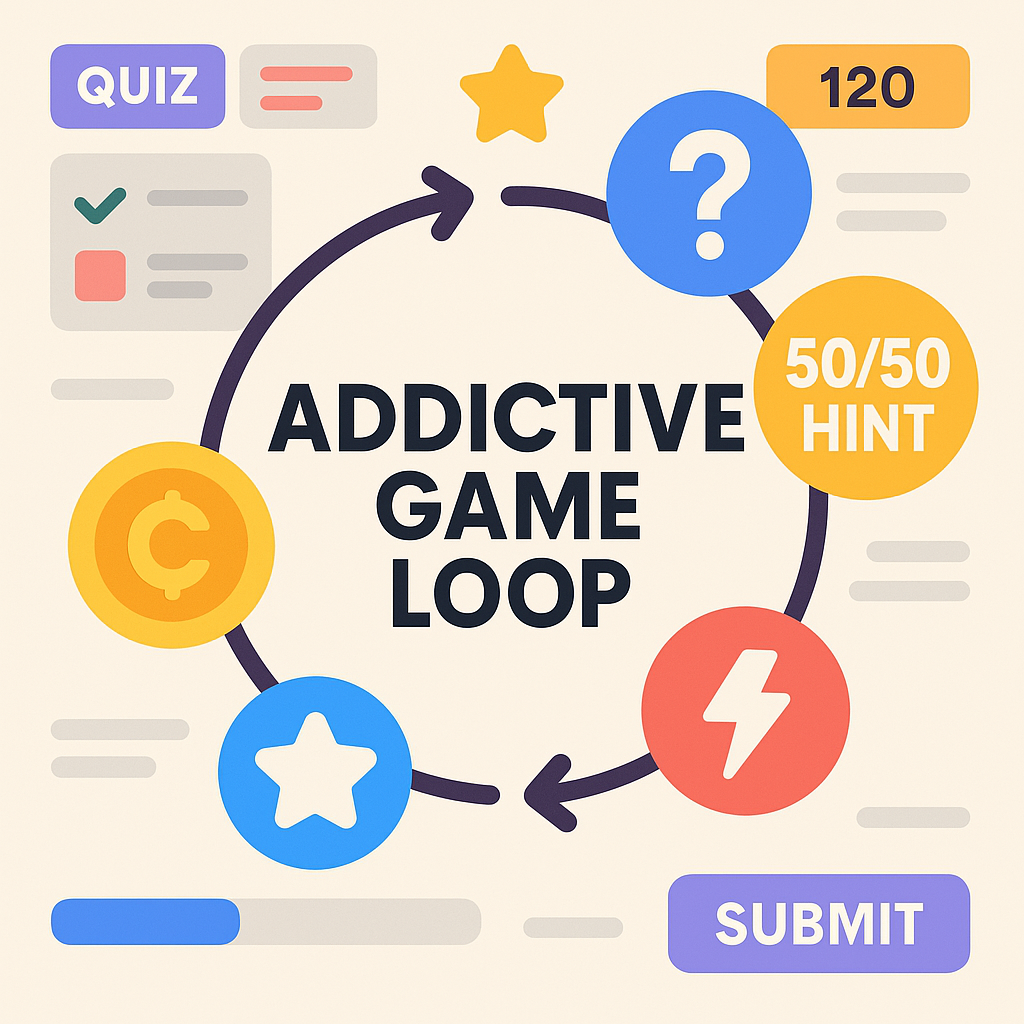In the world of game development, one concept separates forgettable games from unputdownable ones — the core game loop. Whether you’re making a hyper-casual mobile game or a deep strategy title, designing an addictive game loop is key to high retention, monetization, and virality.
In this article, we’ll break down what a game loop is, why it works, and how to design one that players can’t stop engaging with.
What is a Game Loop?
A game loop is the repeated sequence of actions players take within your game. It’s the basic rhythm of gameplay that provides feedback, rewards, and a reason to play again.
Think of it as the cycle of:
Do → Get Feedback → Get Reward → Repeat
🔁 Example from Popular Games:
- Subway Surfers: Run → Collect Coins → Crash → Upgrade → Run Again
- Clash Royale: Battle → Win/Lose → Get Chest → Unlock Cards → Battle Again
- Candy Crush: Match → Clear → Score → Advance → Match Again

🧠 Why Are Game Loops So Addictive?
Game loops play on psychological hooks like:
- Instant Feedback (dopamine hit from scoring or progress)
- Short-Term Goals (complete a level, collect an item)
- Long-Term Progression (unlock skins, reach next level)
- Uncertainty & Surprise (loot boxes, random rewards)
These loops trigger intrinsic motivation, making players come back even without external nudges.
🧩 The Three Layers of a Great Game Loop
To build a game that truly sticks, layer your loops:
1. Core Loop (Seconds to Minutes)
The main action your player repeats often
Example: Jumping over obstacles in a runner game
2. Mid-Term Loop (Minutes to Hours)
Slightly longer goals that build on the core
Example: Completing a set of levels or collecting enough coins to buy something
3. Meta Loop (Hours to Days)
Long-term progression that builds emotional investment
Example: Leveling up characters, unlocking worlds, daily missions
🔨 How to Design an Addictive Core Loop
1. Make the Main Action Satisfying
- Add visual and sound feedback (particles, pops, bounces)
- Make it “feel” good — animations and timing matter
2. Reward Quickly and Clearly
- Use coins, score, power-ups or audio rewards
- Show immediate feedback (e.g., coin counter ticks up)
3. Create Progression and Mastery
- Add increasing challenges and skill-based elements
- Introduce new mechanics gradually to avoid boredom
4. Use Variable Rewards
- Mix predictable and surprise rewards (e.g., daily spins, loot drops)
- Keeps dopamine levels spiked and engagement high
5. Design for Replayability
- Add randomness or changing environments
- Give players multiple goals (score, collection, unlocks)
✅ Example: Building a Game Loop for a Hyper-Casual Game
Game Idea: “Falling Letters”
Core Loop: Catch falling letters → Form a word → Get score → Repeat
Mid-Term Loop: Complete word streaks → Earn stars
Meta Loop: Unlock new themes/levels → Compete on leaderboards
You can see how simple mechanics evolve into engaging loops just by adding layers of progression and reward.
🚫 Common Mistakes to Avoid
- Too much complexity early on – kills the simplicity of the loop
- No meaningful progression – leads to burnout
- Rewards without emotional impact – coins that don’t matter won’t excite anyone
- Too long or too short loops – balance is key to keeping attention
📈 Bonus: How Game Loops Affect Monetizatio
An addictive loop:
- Increases session time
- Encourages repeat play
- Drives more ad impressions and IAPs
When players are engaged in loops, they’re more likely to:
- Watch rewarded ads
- Buy boosters or cosmetic items
- Return for daily rewards
🔚 Final Thoughts
Designing an addictive game loop isn’t just about fun — it’s about creating an emotional rhythm that brings players back again and again. The best loops feel intuitive, rewarding, and progressively challenging.
Whether you’re building a casual mobile title or a complex strategy game, mastering the game loop is your first step toward building something truly sticky.
Read More about How Game Developers Make Money: Ads vs. In-App Purchases
Learn More about:
Gaming Psychology: Why We’re Hooked and How Developers Keep Us Engaged
And a great Article on User Retention by Adjust
User retention: How to successfully keep users and grow your app



